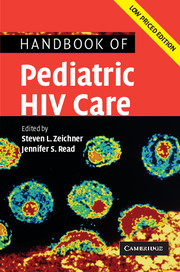Book contents
- Frontmatter
- Contents
- List of contributors
- List of abbreviations
- Foreword
- Preface
- Part I Scientific basis of pediatric HIV care
- Part II General issues in the care of pediatric HIV patients
- Part III Antiretroviral therapy
- 11 Antiretroviral therapy
- 12 Antiretroviral drug interactions
- 13 Metabolic complications of antiretroviral therapy in children
- 14 HIV drug resistance
- 15 Initiating and changing antiretroviral therapy
- 16 Therapeutic drug monitoring
- 17 HIV postexposure prophylaxis for pediatric patients
- Part IV Clinical manifestations of HIV infection in children
- Part V Infectious problems in pediatric HIV disease
- Part VI Medical, social, and legal issues
- Appendix 1 Formulary of antiretroviral agents
- Appendix 2 National Institutes of Health sponsored clinical trials for pediatric HIV disease
- Appendix 3 Selected HIV-related internet resources
- Appendix 4 Selected legal resources for HIV-infected children
- Index
- References
16 - Therapeutic drug monitoring
Published online by Cambridge University Press: 23 December 2009
- Frontmatter
- Contents
- List of contributors
- List of abbreviations
- Foreword
- Preface
- Part I Scientific basis of pediatric HIV care
- Part II General issues in the care of pediatric HIV patients
- Part III Antiretroviral therapy
- 11 Antiretroviral therapy
- 12 Antiretroviral drug interactions
- 13 Metabolic complications of antiretroviral therapy in children
- 14 HIV drug resistance
- 15 Initiating and changing antiretroviral therapy
- 16 Therapeutic drug monitoring
- 17 HIV postexposure prophylaxis for pediatric patients
- Part IV Clinical manifestations of HIV infection in children
- Part V Infectious problems in pediatric HIV disease
- Part VI Medical, social, and legal issues
- Appendix 1 Formulary of antiretroviral agents
- Appendix 2 National Institutes of Health sponsored clinical trials for pediatric HIV disease
- Appendix 3 Selected HIV-related internet resources
- Appendix 4 Selected legal resources for HIV-infected children
- Index
- References
Summary
Therapeutic drug monitoring (TDM) refers to the adjustment of drug doses based on measured plasma concentrations to attain values within a “therapeutic window.” Clinicians have used these principles for years to adjust doses of many drugs, however, TDM has not generally been used for monitoring the treatment of chronic infectious diseases. There is growing evidence that TDM may be useful in some circumstances to ensure HIV-infected patients have adequate blood concentrations for efficacy without producing toxicity. This may be especially true for children where there is wide variability in plasma concentrations. A number of critical questions remain to be addressed before TDM is used routinely in HIV infection.
Retrospective studies have demonstrated plasma concentrations of antiretroviral drugs correlate with antiviral activity [1–4]. It is clear that drug concentrations are an important predictor of response to HIV treatment. However, these findings are quite different than assessing the value of using TDM in the clinic to guide antiretroviral therapy for an individual.
Drugs as TDM candidates
Some antiretrovirals share many of the characteristics of drugs that require monitoring of plasma levels, including variable inter-subject pharmacokinetics, serious consequences if there is a lack of effect or drug toxicity, documented relationships between drug concentration and effect or toxicity, identification of a therapeutic range, and the availability of rapid and accurate assays.
Plasma concentrations of protease inhibitors (PIs) may vary by more than ten-fold between individuals receiving the same dose [5].
- Type
- Chapter
- Information
- Handbook of Pediatric HIV Care , pp. 439 - 449Publisher: Cambridge University PressPrint publication year: 2006



